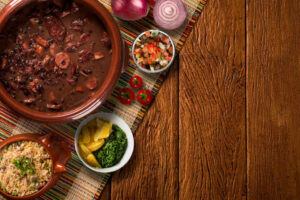Partying is for Brazilians! But it has to be our way. If we celebrate Carnival, Easter It is Christmas our way, it would be no different with the June festival. Take a tradition from here, another from there, adapt the language, add a lot of food and that's it: we have a party that, if not unique, is only celebrated this way in Brazil.
The June festival arrived here with the Portuguese (the name there is Festival of Popular Saints), at the time of colonization, with many references borrowed from other cultures. The main one, the month in which they are carried out.
Long before we paid homage to the three Catholic saints (Saint Anthony, Saint John and Saint Peter), pagan tradition already separated the month of June, the time of the summer solstice in the northern hemisphere, to celebrate their gods in exchange for good harvests and plantations. . It is from this time that, for example, the tradition of making bonfires, releasing balloons, dancing and singing comes from.
But after it arrived here, the June festivities received another layer of influences, absorbing elements from African and indigenous cultures until arriving at what we now know as June festival (which, incidentally, can also vary from state to state).
Find out how we Brazilianized — and, between us, improved — the June festivities.
A quadrille turned into a gang
The June party gang is inspired by quadrille, dance practiced at the balls of the aristocracy of 18th century France. It was first imported to England (where it was named peasant) and then came here at the hands of the Portuguese.
But in Brazil it was redesigned and received scenic elements (the tragicomic story of the wedding), a costume with a bunch of props, in addition to the participation of more musical instruments and the Brazilianization of French expressions used to dictate the steps that the participants of the gang take. should do.
The language school website French alliance explains where balancê, anarriê and tur come from (which, depending on where you live, comes with a loaded erre).
- Alavantú – is the same as in advance, the command for the couples in the gang to start walking.
- Anarriê – also known as in arrière, the command to walk backwards.
- Changê – the adaptation for changer/changez, when couples switch partners.
- Otrefoá – or you were, that is, repeat the previous step.
- Balancê – is the balancer, when everyone must move their bodies to follow the rhythm of the music. It is usually spoken after a step is finished.
- Tur – or tour, when ladies and cavalheiros take a complete turn.
In addition to the adaptation of the French square dance, there is also a very Brazilian way of dancing (or playing) the June festival in Brazil. Bumba Meu Boi, very popular in Maranhão, is so unique that it was elected, in 2019, intangible cultural heritage of humanity by UNESCO.
The festival is influenced by indigenous, African and Portuguese cultures and represents the legend of Mother Catirina, Father Francisco and the miracle of the healing or resurrection of an ox. The groups that participate in the festivities have an aesthetic called accent, which provides its own rhythm, characters, costumes, instruments and dance.
June and July festivities
The June festivities are not restricted to the three days of the honored saints, namely, June 13th (Santo Antônio), June 24th (São João) and June 29th (São Pedro). Throughout the month of June, especially on weekends, it's easy to find a June party to go to.
The desire to celebrate is so great that the festivities have already gone beyond the month of June and invaded the following month, earning the simple nickname of July festivals.
Do you have a party? So there's a lot of music
In Portugal, the Festa dos Santos Populares has a Carnival feel, with marches and block parades.
In Brazil the soundtrack varies between forró, country music and Bumba Meu Boi tunes. So much diversity of sounds and rhythms provides a multitude of musical instruments used for everyone to dance or play during the June festivities.
Mulled wine and corn? It's only here
There are significant differences between what is eaten at the June festival here and in Portugal, largely due to the climate and seasonality. In the European country, instead of mulled and quentão wine (cold drinks), sangria, draft beer and sour cherries are consumed, much cooler drinks.
There, the typical party menu includes grilled sardines (due to the fishing season) and bifanas, a sandwich made with thin cuts of grilled pork. Here the June festival foods inherited the love for corn, cassava and peanuts from the indigenous tradition. But of course, it also has a Portuguese influence, as we see in hominy and rice pudding.
It's not a lie! There's a June party for delivery
A self-respecting June festival has a lot of food, for all tastes. Anyone who wants to host their own June party at home can open the iFood app and order a sweet or savory dish (or both, in the June kit) to get home quickly.
Check out the June dishes you can order on iFood.
Savory Dishes
- Green soup
- Angu
- Sausage
- Kebab
- Pinion
- Bean soup
Sweet Dishes
- fool
- Curau
- Corn cake
- Hot hominy (with paçoca or without)
- Rapadura
- Paçoca Cake
Moleque's Foot


